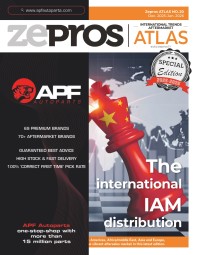
F. Katsardis, Temot: "Temot remains the only homogeneous ITG network unifying family SMEs"

Throughout 2022-23, Temot International worked to strengthen the ecosystem around its shareholders and their supplier partners. Objective: consolidate its global positions. Its president shares with us his assessment and his analysis of the market at a global level.
On what note has Temot ended 2023?
Fotios Katsardis: Temot is finishing the year with 112 shareholders (+10 vs 2022) in 102 countries, for a consolidated turnover by its members that should reach around €16-17bn (vs €14bn in 2022). This position is underpinned by our unique business model, which limits the number of shareholders per country and per sector. Our priority remains to support the existing core by improving its compe- titiveness in the market, which has been challenged by widespread consolidation and some of our suppliers’ commercial policies. Throughout 2022-23, following a number of strategic realignments, mainly driven by mergers and acquisitions in which we were involved, have solidified our position as a global organisation made up mainly of leading small and medium-sized enterprises (SMEs). This makes us a particularly homogeneous alliance. The success of our strategy lies in concentrating our purchasing on our premium supplier partners. Moreover, we do not have a private label strategy.
How do you see the markets on the four continents evolving?
F. K.: The APAC region is experiencing significant growth, but it would be wrong to lump together nations such as Japan, Korea, China, Indonesia, Australia, Vietnam, Thailand and India. Each country has unique characteristics; for example, 10% growth in Japan is a commendable achievement, while the same percentage in China could be considered less than its natural growth. In Latin America, the growth models are promising, but we need to distinguish between the Pacific and Atlantic regions. The same nuance is imperative for Africa, given the significant differences between South Africa, sub-Saharan Africa, and the French-and English-speaking zones. The influence of external factors such as Dubai, the problems of counterfeit goods and corruption, and Africa’s potential to become a key player in the automotive sector by 2050 must also be taken into account. With regard to Europe, the landscape is equally complex, with distinct dynamics in Eastern, Western, Southern and Northern Europe.
Is market concentration still a force in play?
F. K.: Concentration within the industry is becoming increasingly selective and remains a valid factor. However, at retail level we are seeing the emergence of the notion of ’coopetition’ - a mixture of cooperation and competition. These alliances, in which companies work together in some areas while competing in others, will be key to navigating the complex dynamics of the market.

What is your take on sustainable development?
F. K.: As things stand, while the individual efforts of some colleagues are commendable, our sector’s approach to the subject of sustainability is lacklustre, bordering on apathetic. There is a glaring lack of coordinated action in our aftermarket. Apart from large companies, often forced by governance structures to adopt sustainable practices, medium-sized companies, while aware of the importance of the issue, often lack clear direction. This results in fragmented efforts. Our associations are getting directly involved in projects, which is a positive step. A systematic overhaul of our practices in this area is needed to develop a coherent industry-wide strategy if we are to make significant progress in this area. This requires clear guide-lines, achievable targets and a unified commitment across all sizes of business. By looking for quick wins without a real sector-wide approach, we run the risk of manufacturers ’kidnapping’ the whole issue.
On what global markets can you see electrification becoming a theme to watch out for among aftermarket players?
F. K.: European countries are at the forefront of electrification, with strict emissions regulations and ambitious climate targets. And their impact is beginning to be felt in the aftermarket. The same is true of North America. However, this will take longer than in Europe. China is now the world’s largest market for electric vehicles. With its considerable volume of electrified vehicles, this market is crucial for suitable after-sales services. It is also an area in which new players will emerge if geopolitics allow. Japan and South Korea, which are lagging behind, are also getting in on the act, and since they have a solid automotive industry, they will become major markets in terms of electromobility. On these markets, aftermarket players are already preparing to handle these vehicles. This requires expertise in battery management, electric motor maintenance and software updates. What’s more, the roll-out of charging point infrastructure should open up opportunities for new services and partnerships for players in the aftermarket. The market is materialising. A great many electric vehicles have arrived in our garages in recent months... Can we repair them? Yes, but with difficulty because they are data strongholds. Digitisation is a question we can answer once we have the data to use from the tools.
What is the big trend of the future?
F. K.: Whatever the drivetrain technology, we expect to see a substantial expansion of Online-to-Offline (O2O) systems over the next decade. Technological advances, particularly in artificial intelligence, are preparing the ground to revolutionise our interactions with all levels of customers. This trend is already evident in China and is gaining ground in the US.
Retrouvez la version en Français : F. Katsardis, Temot : « Temot reste le seul réseau ITG homogène fédérateur de PME familiales »






